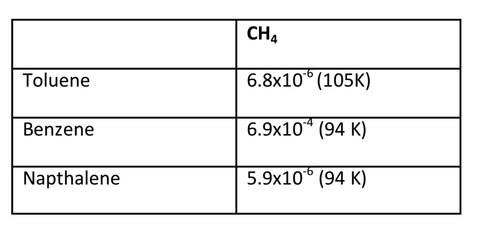2011 Annual Science Report
 NASA Jet Propulsion Laboratory - Titan
Reporting | SEP 2010 – AUG 2011
NASA Jet Propulsion Laboratory - Titan
Reporting | SEP 2010 – AUG 2011
Task 3.3.1 Solubility of Gases and Organics in Liquid Methane and Ethane
Project Summary
The solubilities of gases and organics in liquid ethane and methane have been measured.
Project Progress
Widespread lakes of liquid methane and ethane were discovered on Titan by the Cassini mission in 2006, which naturally motivates questions about the solubility of surface and atmospheric materials in the liquid.
Co-Investigator Robert Hodyss and Postdoctoral Fellow Mathieu Choukroun have collected measurements of the solubility of gases in liquid ethane and methane, using the quadrupole mass spectrometer system that was developed in the first year of this work. Briefly, a quadrupole mass spectrometer (SRS 200) in a small vacuum chamber is used to sample liquids through a capillary into the mass spectrometer. Liquid drawn into the capillary will rapidly vaporize and be analyzed with the mass spectrometer. Saturated solutions of rare gas are made by first condensing ethane in a liquid nitrogen- cooled, temperature controlled dewar, then bubbling the rare gas of interest through the solution until saturation is reached. The solubilities of argon and krypton in liquid ethane and methane are listed in the table below (Table 1) and are consistent with theoretical values. A publication based on this work which details the implications for Titan’s surface chemistry is in progress. The solubilities of several small aromatics are also currently being measured (see Table 2). This method of sampling and analysis of liquid hydrocarbon solutions could also be easily adapted for in situ Titan missions with the goal of sampling Titan’s lakes.
Hodyss and Choukroiun have used two different experimental approaches for the determination of solubilities in liquid hydrocarbons. In addition to mass spectrometry, they determine solubilities via ultraviolet (UV) absorption spectroscopy of solutions of liquid methane and appropriate solutes.
The relatively high organic solubilities, as shown in Table 2, suggest that liquid hydrocarbon-based weathering and sorting of surface organics should be occurring on Titan.
Table 1. Gas solubilities in liquid methane and ethane at 94 K. Units are in mole fraction.
Table 2. Aromatic solubilities in liquid methane. Units are in mole fraction.
-
PROJECT INVESTIGATORS:
-
PROJECT MEMBERS:
Mathieu Choukroun
Postdoc
-
RELATED OBJECTIVES:
Objective 1.1
Formation and evolution of habitable planets.
Objective 2.2
Outer Solar System exploration
Objective 3.1
Sources of prebiotic materials and catalysts


